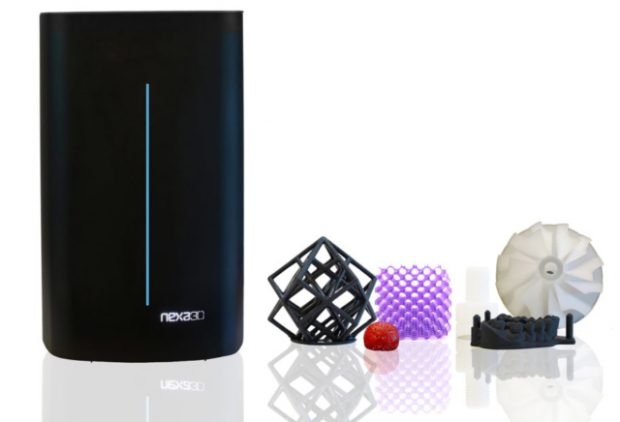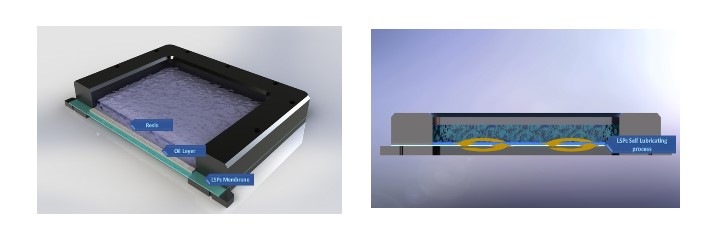Behind the Scenes with Nexa3D, XYZ Printing and Avi Reichental
Latest News
July 27, 2018
RT-12792~“Behind the Scenes with Nexa3D, XYZ Printing and Avi Reichental”~“Avi Reichental must never sleep, given the number and variety of additive manufacturing (AM)/3D printing endeavors with which he is involved. Drawing upon his deep experience in the field, particularly honed during his years as CEO of 3D Systems, Reichental now carries the title of founder, chairman, CEO and/or general partner at such companies as NXT Factory, DWS Systems, Nano Dimension, Xponential Works, the OurCrowd Cognitiv Ventures Fund and Nexa3D, as well as advisor to XYZ Printing.
 Nexa3D voxel-level desktop printer with sample high-resolution parts. This 3D printer uses liquid sublayer photo-curing (LSPc) to build resin-based parts in just hours. Image courtesy of Nexa3D.
Nexa3D voxel-level desktop printer with sample high-resolution parts. This 3D printer uses liquid sublayer photo-curing (LSPc) to build resin-based parts in just hours. Image courtesy of Nexa3D.Recently DE had the chance to hear Reichental’s perspective on the current and near-future state of AM, and particularly to catch up on the joint projects underway at Nexa3D, XYZ Printing and BEGO USA. Nexa3D manufactures a range of “ultra-fast” professional-grade stereolithography printers starting under $20,000; XYZ Printing is a contract manufacturer with more than 35 years of experience; and BEGO USA is a division of a 100-plus-year-old dental material and equipment company.
Breaking the AM Production Speed Barrier
“It’s a very exciting time to be in additive manufacturing and even more exciting to be in high tech,” says Reichental. “We are in an extraordinary period, where this convergence of very powerful, seemingly stand-alone technologies is creating comprehensive disruption in technology business models and ultimately lifestyles. “Just in additive alone,” he adds, “we’re seeing after decades (of work) that companies are breaking the speed barrier. That means that we can truly migrate this technology to the production floor at comparable volumes to traditional injection-molding and die-casting.”
Explaining the evolving thought process behind this, Reichental observes, “After trying to adapt additive to fit into traditional work-flows and design constraints, we’re beginning to see how to design for AM: how do we optimize, how do we harness structures and geometries that truly mimic what was already designed, perfected and patented by nature in ways that enhance performance, reduce material usage and are much more sustainable.”
On the material side, he says we’ve seen the ability to grow or cure parts faster by using newer chemical systems; this allows a faster migration from “digitally mimicking” plastics to bonafide engineered materials. These factors have influenced the five-fold increase in the number of 3D printing companies as compared to five years ago. Particularly in the private-sector venture-funded side of the business, Reichental sees a healthy and vibrant marketplace with more investment and more dollars put into early-stage industrial companies than seen in nearly a decade. He comments, “My sense is there’s never been a better time to be in additive.”
Multiple Marketing Models for AM
Reichental says that the development/marketing plan from day one for Nexa3D was three-pronged: to sell systems directly under the Nexa3D label while in parallel creating both a white-label version licensed to XYZ Printing and an application-specific dental product for BEGO, a global specialty dental business headquartered in Bremen, Germany. He describes the reasoning behind this approach as addressing the two big challenges for any early-stage 3D printing company: access to the market (usually through reseller channels) and buyer concerns that the company will still be around in a few years for support and continuing development.
Now Nexa3D has access to XYZ Printing’s strong reseller channels and the backing of the latter’s well-known international parent company, New Kinpo Group, which earns more than $36 billion annually. The new family of resin 3D printers, based on patented liquid sublayer photo-curing (LSPc) technology, offers high-speed printing targeted to functional prototyping, production tooling and manufacturing of end-use parts. As Reichental notes, “It still matters for engineers to get prototypes in hours, not days.”
 Schematics of Nexa3D’s lubricant sublayer photo-curing (LSPc) technology. The converted, sliced CAD data drives a light source which projects upwards through a transparent, self-lubricating (oil-coated) membrane positioned at the bottom of a resin-filled tray. Image courtesy of Nexa3D.
Schematics of Nexa3D’s lubricant sublayer photo-curing (LSPc) technology. The converted, sliced CAD data drives a light source which projects upwards through a transparent, self-lubricating (oil-coated) membrane positioned at the bottom of a resin-filled tray. Image courtesy of Nexa3D.As the technology developer, Nexa3D is also able to market directly in a complementary way, which is how the company entered the growing dental marketplace and connected with BEGO. Under its own label, BEGO will sell custom Nexa3D printers (manufactured by XYZ Printing) to support the growing shift of dental laboratories to a completely digital workflow. This is expected to be a game-changer for larger labs and, given the development of semi-permanent and permanent 3D printed dental restoration materials, will even become an in-clinic solution. Thus, the logical connection with BEGO, which is highly experienced in dental materials and FDA approval procedures.
Nexa3D printers
From the start, Nexa 3D has made voxel-level printing the basis of its LSPc technology. Per the company website, the process involves a “beam delivery matrix that uses an optical array in combination with continuous and sequential coating. Printed voxels are suspended in a proprietary solution releasing layer surface tension.” The continuous nature of the curing allows the printer to reach top speeds of 1 cm per minute.
“We started with an NXV model that was akin to the XYZ 180,” says Reichental, “and then had a few breakthroughs and realized we could increase the build size quite a bit. We migrated to the larger build size with the Mfg Pro 220 xPF (announced at April’s RAPID + TCT 2018), and at this year’s Formnext we will unveil build platforms (for both Nexa3D and XYZ) with volumes about twice that available today in this class of printer.” Thirty Pro220s have already been ordered by Techniplas for a variety of automotive applications.
Increasing build volume is not the only work in progress. The Pro220 systems use machine learning/AI algorithms to intelligently slice, orient and support complex geometries at uniform speed and high resolution (up to 30 microns XY axis), helping non-expert users achieve excellent results. Smart sensors already track material flow, temperature and viscosity; newer systems will include even more predictive capabilities and all layers of the system architecture will be Industry 4.0 connected.
Reichental sees future Nexa3D products incorporating blockchain security, data encryption, on-board / cloud-based monitoring, and elements of robotics and autonomous vehicles. The company is targeting “most valuable player status”—and he says no product today will win MVP without being predictive and having augmented reality. Possibilities are wide open because, as a new company, he says, “Nexa3D has no institutional legacy or inertia—it is not building on the shoulders of previous products.” An interesting observation coming from a long-time veteran in the AM field.
Sources: Nexa3D, XYZ Printing and BEGO USA.”
Subscribe to our FREE magazine, FREE email newsletters or both!
Latest News
About the Author
Pamela Waterman worked as Digital Engineering’s contributing editor for two decades. Contact her via .(JavaScript must be enabled to view this email address).
Follow DE





